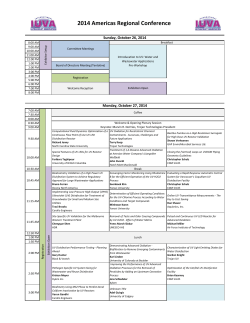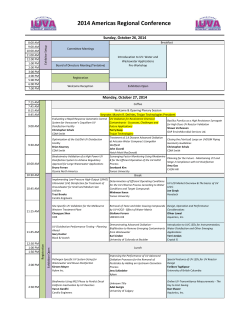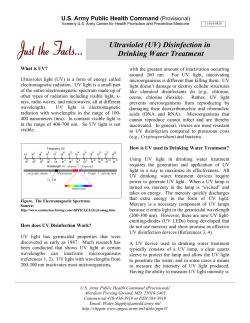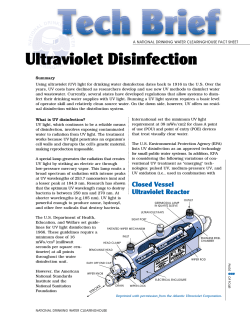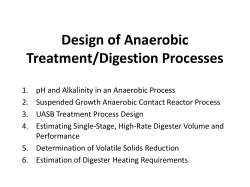
Small Wastewater Treatment Systems By Michael Albanese, P.Eng. H2FLOW EQUI PMENT INC.
Small Wastewater Treatment Systems By Michael Albanese, P.Eng. H2FLOW EQUI PMENT INC. www.h2flow.com Why do you need one? • Typical Reasons – – – – – – – – – Enviromental Regulations New Development Failing Septic Systems Cost of Sewers & Pumping to Closest Municipality Centralized Operations may be costly Politics Autonomy Keeping the Water Reuse What are you looking for? A low cost, highly efficient wastewater treatment system capable of consistently producing: < 5-10 mg/ L BOD < 5-10 mg/ L TSS < 0.5-2 mg/ L NH3 < 0.1-0.5 mg/ L TP < 200 FColi / 100ml TN ? ….. with minimal electrical cost, high degree of automation, low operator attention and minimal sludge production !!!! (I WILL ORDER ONE OF THOSE, THANKS VERY MUCH…..) Definitions • On-Site systems for 0 to 5m3/ day and can be up to 20 m3/ day • A small wastewater plant is usually referred to flows between 10 to 300 m3/ day but can range up to 3800 m3/ day • We will focus on 20m to 300m3/ day range 5th Wheel Truck Stop WWTP – Dorchester, ON – 45m3/ day SBR What is a Package Plant? • Term “package plant” is loosely used • Industry definition is a transportable plant that comes pre-assembled ready for plug and play, made in steel or pre-cast tankage • Sometimes this term is also used to refer to small pre-engineered plants which are poured in place concrete. Should be referred to as Pre-Engineered plants Sentinel WWTP – 33m3/ day SBR Photos Courtesy of Fluidyne Package & Pre-Engineered Plants Photo Courtesy of Eimco Water Inc. PACKAGE PLANT (usually up to 200m3/ day) Steel or Pre-cast Tanks Photo Courtesy of Eimco Water Inc. PRE-ENGINEERED PLANT (usually up to 3800m3/ day) Poured In Place Concrete Tanks Package & Pre-Engineered Plants Photo Courtesy of Eimco Water Inc. PACKAGE PLANT PRE-ENGINEERED PLANT (usually up to 200m3/ day) (usually up to 3800m3/ day) Steel or Pre-cast Tanks Poured In Place Concrete Tanks Types of Small Plants Most Common Biological Processes: • • • • • • Extended Aeration RBC (Rotating Biological Contactor) SBR (Sequencing Batch Reactor) ISAM (Modified SBR) MBR (Membrane Bio Reactor) Others (Contact Stabilization, Lagoon) not discussed as they are not common or no longer marketed Extended Aeration • • • • Rectangular up to 400 m3/ d Concentric Design > 400m3/ d Very popular up to recent years Usually Consists of : - Aeration Tank ( outboard) - Clarifier ( internal tank) PLUS - Aerobic Digester - Disinfection - Equalization Chamber - Tertiary Filters • Continuous Flow Discharge • Declined in popularity as better processes w ent on the market Photo Courtesy of Permastore Ltd. Extended Aeration Sample Plan Layout Influent Aerobic Digester Equalization Chamber Clarifier Tertiary Filters Disinfection Effluent Aeration Tank Rotating Biological Contactor • Declined in popularity due to mechanical issues and low effluent quality • Usually Consists of : - Primary Tank - Rotaring Disk - Secondary Clarifier PLUS - Aerobic Digester - Disinfection Chamber - Tertiary Filters • Continuous Flow Discharge • Needs to be covered • Low operator attention Rotating Biological Contactor Sample Plan Layout Aerobic Digester I nfluent Secondary Clarifier Equalization Chamber Tertiary Filters Disinfection Effluent RBC Primary Clarifier Sequencing Batch Reactor • • • • • Modified Exended Air Process Mostly Rectangular Batch Discharge Various Variations Usually Consists of : - Selector Tanks - Upstream Equalization Tank or Tw o Tanks in series - Tank for React/ Settle/ Decant PLUS - Aerobic Digester - Post Equalization Chamber - Disinfection - Tertiary Filters Inglewood WWTP - Region of Peel – 243m3/ day SBR Coldwater WWTP – Springwater Township – 300m3/ day SBR Sequencing Batch Reactor SBR Steps: Fill, React, Settle, Decant & Idle Sequencing Batch Reactor Single Train Layout Aerobic Digester I nfluent Equalization Chamber Post Equalization Chamber Tertiary Filters Disinfection Effluent SBR Optional Selector Tank Sequencing Batch Reactor I nfluent SBR Optional Selector Tank Aerobic Digester Tertiary Filters Disinfection SBR Post Equalization Dual Train Layout Effluent Modified Sequencing Batch Reactor (ISAM) • • Rectangular Batch Discharge w ith Fill, I nteract, Settle, Decant • Usually Consists of : - Anaerobic Trash Trap Tanks - Equalization Tank - React/ Settle/ Decant Tank PLUS - Post Equalization Chamber - Disinfection - Tertiary Filters • Low sludge production Modified Sequencing Batch Reactor (ISAM) Sample Plan Layout Post Equalization Chamber I nfluent Anaerobic Surge Chamber/ Anoxic Mix Thrash Trap Equal. Tank Tertiary Filter SBR Disinfection Effluent Membrane Bio Reactor • • • Mostly Rectangular Continuous Discharge Various Variations - Selector / Anoxic Zone - Aeration Zone - Membranes as Clarifier PLUS - Aerobic Digester - Disinfection • • • NO Tertiary Filters Smallest Footprint Some MBR models can thicken sludge Aeration Zone Anoxic Zone MBR Zone Membrane Bio Reactor Sample Plan Layout Aerobic Digester I nfluent Equalization Chamber MBR Disinfection Effluent Optional Anoxic Selector Tank Membrane Bio Reactor 38 m3/ day Footrpint Based on EIMCO WATER/ KUBOTA MBR Design Issues • Large fluctuations in flow and BOD loads - (watch your pump sizing!) • Effluent Limits may determine which technology • External Loads like Septage – this is high BOD load – we need to design for it • Sludge Production and Disposal - usually removed by vac truck, but if you can produce less that reduces frequency • Odour considerations if neighbours are nearby • Pretreatment; Screening, Grinding or Trash Trap • Downstream processes; Filters and Disinfection Large fluctuations in loads Hydraulic shock loads and large variation in flows from small communities are accentuated by the use of oversized pumps where wastewater is pumped. Example: Based on per capita unit flow, you determine you need a 30m3/ day plant for a community. 120 lpm @20ft head When pump is on it equates to 173m3/ d ! Smallest sewage pump (2”) is rated for (about 6 times ADF). Designing for 8-10 is not uncommon, by using equalization tanks. Pretreatment • Fine screening is recommended (and is a must for MBR) • Grinding can be adequate for SBR, ExAir, RBC • Trash trap works well for SBR, ExAir • Grit removal may be required but for small systems it is typically not included or use Trash trap • Size for Instantaneous Peak Flow not ADF Channel Grinder – Photo Courtesy of Franklin Miller Corp. Pretreatment – Screening • If screening, then fine screening is recommended (6mm openings) • 2 or 3mm if going with MBR • Removes grease balls! • Screw Screen popular choice • Will have to dispose of removed screened material • Bagger Unit can help with odours and housekeeping • Can be located outdoors (no building) but must equip screening unit with heat tracing and insulation. Screw Screen – Photo Courtesy of Parkson Corp. Tertiary Filters • Pressure filter type or Continuous Backwash Type • Not needed for MBR • Size for Instantaneous Peak Flow not ADF • Watch Volume of Backwash! Snow Valley Ski Hill WWTP – Pressure Filters Dynasand – Photo Courtesy of Parkson Corp. Disinfection • UV or Chlorine are typical • With Chlorine, Dechlorination is needed more and more • UV is simple, no chemicals, less operator attendance • Can be inside or outside building • Size for Instantaneous Peak Flow UV unit indoors – Photo Courtesy of Trojan I nc. UV unit outdoors – Photo Courtesy of Trojan I nc. SUMMARY This presentation was mainly an overview of available technologies for small wastewater treatment plants, plus considerations and general design issues associated with them. In conclusion: Select your treatment system process based on • • • • • • • • Capital cost Operational costs Site Conditions (Temperature) Effluent criteria Sludge production Footprint References Support THANK YOU VERY MUCH ! Small Wastewater Treatment Systems Any questions? By Michael Albanese, P.Eng. H2FLOW EQUI PMENT INC. www.h2flow.com
© Copyright 2025
